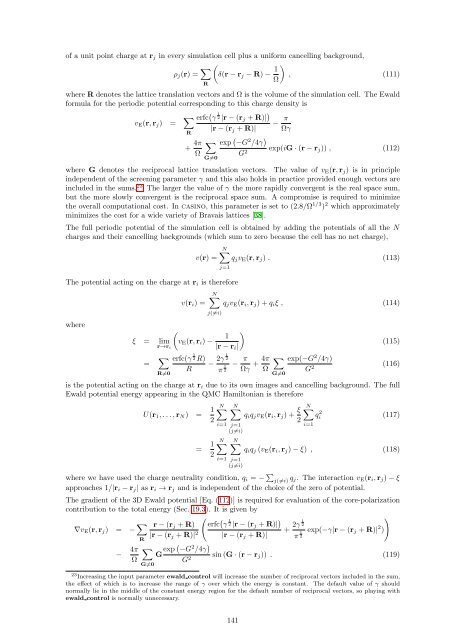CASINO manual - Theory of Condensed Matter
CASINO manual - Theory of Condensed Matter
CASINO manual - Theory of Condensed Matter
You also want an ePaper? Increase the reach of your titles
YUMPU automatically turns print PDFs into web optimized ePapers that Google loves.
<strong>of</strong> a unit point charge at r j in every simulation cell plus a uniform cancelling background,<br />
ρ j (r) = ∑ (<br />
δ(r − r j − R) − 1 )<br />
, (111)<br />
Ω<br />
R<br />
where R denotes the lattice translation vectors and Ω is the volume <strong>of</strong> the simulation cell. The Ewald<br />
formula for the periodic potential corresponding to this charge density is<br />
v E (r, r j ) = ∑ erfc ( γ 1 2 |r − (r j + R)| )<br />
− π |r − (r j + R)| Ωγ<br />
R<br />
+ 4π ∑ exp ( −G 2 /4γ )<br />
Ω<br />
G 2 exp(iG · (r − r j )) , (112)<br />
G≠0<br />
where G denotes the reciprocal lattice translation vectors. The value <strong>of</strong> v E (r, r j ) is in principle<br />
independent <strong>of</strong> the screening parameter γ and this also holds in practice provided enough vectors are<br />
included in the sums. 23 The larger the value <strong>of</strong> γ the more rapidly convergent is the real space sum,<br />
but the more slowly convergent is the reciprocal space sum. A compromise is required to minimize<br />
the overall computational cost. In casino, this parameter is set to (2.8/Ω 1/3 ) 2 which approximately<br />
minimizes the cost for a wide variety <strong>of</strong> Bravais lattices [38].<br />
The full periodic potential <strong>of</strong> the simulation cell is obtained by adding the potentials <strong>of</strong> all the N<br />
charges and their cancelling backgrounds (which sum to zero because the cell has no net charge),<br />
v(r) =<br />
N∑<br />
q j v E (r, r j ) . (113)<br />
j=1<br />
The potential acting on the charge at r i is therefore<br />
where<br />
v(r i ) =<br />
N∑<br />
q j v E (r i , r j ) + q i ξ , (114)<br />
j(≠i)<br />
(<br />
)<br />
1<br />
ξ = lim v E (r, r i ) −<br />
r→ri |r − r i |<br />
= ∑ R≠0<br />
erfc(γ 1 2 R)<br />
R<br />
− 2γ 1 2<br />
π 1 2<br />
− π Ωγ + 4π Ω<br />
∑<br />
G≠0<br />
(115)<br />
exp(−G 2 /4γ)<br />
G 2 (116)<br />
is the potential acting on the charge at r i due to its own images and cancelling background. The full<br />
Ewald potential energy appearing in the QMC Hamiltonian is therefore<br />
U(r 1 , . . . , r N ) = 1 2<br />
= 1 2<br />
N∑<br />
i=1 j=1<br />
(j≠i)<br />
N∑<br />
i=1 j=1<br />
(j≠i)<br />
N∑<br />
q i q j v E (r i , r j ) + ξ 2<br />
N∑<br />
qi 2 (117)<br />
i=1<br />
N∑<br />
q i q j (v E (r i , r j ) − ξ) , (118)<br />
where we have used the charge neutrality condition, q i = − ∑ j(≠i) q j. The interaction v E (r i , r j ) − ξ<br />
approaches 1/|r i − r j | as r i → r j and is independent <strong>of</strong> the choice <strong>of</strong> the zero <strong>of</strong> potential.<br />
The gradient <strong>of</strong> the 3D Ewald potential [Eq. (112)] is required for evaluation <strong>of</strong> the core-polarization<br />
contribution to the total energy (Sec. 19.3). It is given by<br />
∇v E (r, r j ) = − ∑ ( ( 1<br />
r − (r j + R) erfc γ 2 |r − (r j + R)| )<br />
)<br />
|r − (r j + R)| 2 + 2γ 1 2<br />
exp(−γ|r − (r<br />
|r − (r j + R)| π 1 j + R)| 2 )<br />
2<br />
R<br />
−<br />
4π ∑<br />
G exp ( −G 2 /4γ )<br />
Ω<br />
G 2 sin (G · (r − r j )) . (119)<br />
G≠0<br />
23 Increasing the input parameter ewald control will increase the number <strong>of</strong> reciprocal vectors included in the sum,<br />
the effect <strong>of</strong> which is to increase the range <strong>of</strong> γ over which the energy is constant. The default value <strong>of</strong> γ should<br />
normally lie in the middle <strong>of</strong> the constant energy region for the default number <strong>of</strong> reciprocal vectors, so playing with<br />
ewald control is normally unnecessary.<br />
141

















